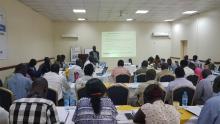With USAID’s support, WHO strengthens integrated diseases surveillance and response for timely and effective public health action in South Sudan
Juba, 13 October 2017: Communicable diseases pose a major public health challenge in South Sudan and cause significant levels of illness, disability, and death for a country also caught in the current conflict.
South Sudan’s weak public health systems aggravate the situation to effectively respond to largely preventable disease outbreaks. Frequent disease outbreaks are driven by multiple factors, including conflict leading to displacement of people and overcrowding and poor environmental conditions.
To enhance capacities for case detection, reporting, investigation, data analysis, outbreak preparedness and response, and feedback, WHO in partnership with the Ministry of Health strengthened the capacity of frontline healthcare workers and rapid response teams on core functions of integrated disease surveillance and response (IDSR) from 9 to 13 October 2017.
Over 40 participants drawn from various institutions of the MoH and WHO were trained to expand the pool of central and state level facilitators to scale up IDSR training at state and county level.
Since 2006, South Sudan has implemented the IDSR strategy with the World Health Organization’s technical support and a financial commitment from the United States Agency for International Development (USAID). In 2013, the Early Warning Alert and Response Network (EWARN) was introduced to complement and enhance the IDSR effectiveness in South Sudan’s conflict-affected states.
Dr Pinyi Nyimol, the Director-General Preventive Health Service in the MoH acknowledged WHO’s role in expanding the pool of central and state level facilitators. He noted that this initiative is vital for strengthening the functioning and performance of the national diseases surveillance system and enhancing capacity and structures for epidemic preparedness and response.
The IDSR is at the center of building a robust national disease surveillance system with capacities for early detection of emerging outbreaks to facilitate rapid outbreak containment in South Sudan. The implementation of IDSR is critical for attaining the International Health Regulations (2005) core capacity requirements for surveillance and response.
The USAID supported project focuses on enhancing capacity to detect and respond to outbreaks, improving reporting performance and data quality at all levels, strengthening National Laboratory capacity to confirm diseases as well as ensuring availability of communication and transportation facilities to improve reporting.
Through the project, hundreds of healthcare workers have been trained on reporting, preparedness and case management of infectious diseases; on outbreak investigation and response; on sample collection, processing, packaging, shipment; and rapid diagnostic testing.
In addition, the project has donated essential logistics including, laptops, motorcycles as well as high-frequency radios to states and counties to improve the weekly surveillance data transmission from the facilities to the state headquarters.
“Over the years of investing in IDSR, reporting performance and capacity to detect outbreaks have improved significantly”, said Dr Wamala Joseph Francis, WHO Epidemiologist. Completeness of IDSR reporting increased from 42% in 2014 to 71% in 2017 and timeliness increased from 27% in 2014 to 64% in 2017.
The IDSR in South Sudan has been instrumental in identifying and responding to disease outbreaks of measles, cholera, malaria, and suspect hemorrhagic fever in 2016 and 2017”, said Mr Evans Liyosi, WHO Representative a.i. for South Sudan. The early detection of these outbreaks has helped MoH, WHO, and partners to target interventions to prevent excess morbidity and mortality. The impact of these interventions can be seen from outcomes of diseases like cholera that has been associated with case fatality rates of up to 15% in humanitarian settings, Mr. Liyosi underscored. Responding to cholera outbreaks within the IDSR context in South Sudan has resulted in a marked reduction of cholera case fatality from 2.6% in 2014 to 1.83% in 2017.
Given South Sudan’s increased vulnerability to disease outbreaks, a continued investment to strengthen IDSR is paramount if excess morbidity and mortality from epidemic-prone diseases are to be averted. WHO’s pledge is to, therefore, continue working with the Ministry of Health and partners to build a robust national disease surveillance system that will foster national and international public health security.
In 2017, the IDSR system helped in identifying, investigating and responding to disease outbreaks of measles, cholera, malaria, Hepatitis E virus, and suspects Guinea worm cases from multiple locations.



